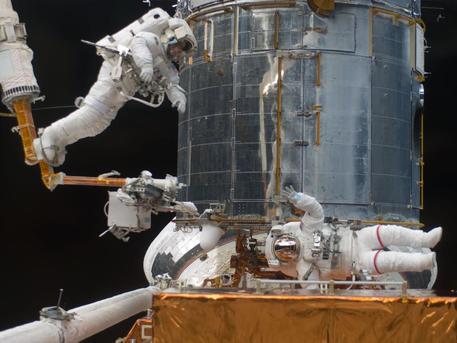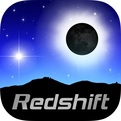Service mission successful so far
Rejuvenating Hubble
 © NASA |
The picture was taken during the third spacewalk and shows the astronauts working on the giant telescope.
Wide Field Camera 3 will be the power behind studies of dark energy and dark matter, the formation of individual stars and the discovery of extremely remote galaxies previously beyond Hubble's vision. WFC3 sees three different kinds of light: near-ultraviolet, visible and near-infrared, though not simultaneously. The camera's range is much greater than that of the instruments currently aboard.
Galaxy evolution, the formation of planets, the rise of the elements needed for life, and the "cosmic web" of gas between galaxies will be some of the areas of study for the Cosmic Origins Spectrograph (COS). A spectrograph is an instrument that breaks light into its component colors, revealing information about the object emitting the light. COS sees exclusively in ultraviolet light and will improve Hubble's ultraviolet sensitivity at least 10 times, and up to 70 times when observing extremely faint objects.
But before it can try out its new equipment, the telescope needs maintenance. The computer that sends commands to Hubble's science instruments malfunctioned 17 days before the planned October 14, 2008 launch date. The mission was postponed to give engineers on the ground time to test the flight spare unit and train the spacewalking astronauts.
Restored and updated, Hubble will continue on its journey around the Earth, its new components merging seamlessly with the old, a rejuvenated telescope ready for years of groundbreaking revelations from the universe.
NASA
Service mission successful so far
Rejuvenating Hubble
 © NASA |
The picture was taken during the third spacewalk and shows the astronauts working on the giant telescope.
Wide Field Camera 3 will be the power behind studies of dark energy and dark matter, the formation of individual stars and the discovery of extremely remote galaxies previously beyond Hubble's vision. WFC3 sees three different kinds of light: near-ultraviolet, visible and near-infrared, though not simultaneously. The camera's range is much greater than that of the instruments currently aboard.
Galaxy evolution, the formation of planets, the rise of the elements needed for life, and the "cosmic web" of gas between galaxies will be some of the areas of study for the Cosmic Origins Spectrograph (COS). A spectrograph is an instrument that breaks light into its component colors, revealing information about the object emitting the light. COS sees exclusively in ultraviolet light and will improve Hubble's ultraviolet sensitivity at least 10 times, and up to 70 times when observing extremely faint objects.
But before it can try out its new equipment, the telescope needs maintenance. The computer that sends commands to Hubble's science instruments malfunctioned 17 days before the planned October 14, 2008 launch date. The mission was postponed to give engineers on the ground time to test the flight spare unit and train the spacewalking astronauts.
Restored and updated, Hubble will continue on its journey around the Earth, its new components merging seamlessly with the old, a rejuvenated telescope ready for years of groundbreaking revelations from the universe.
NASA





